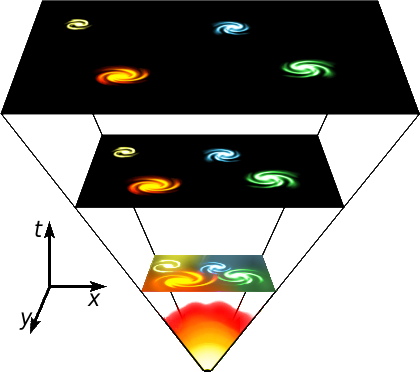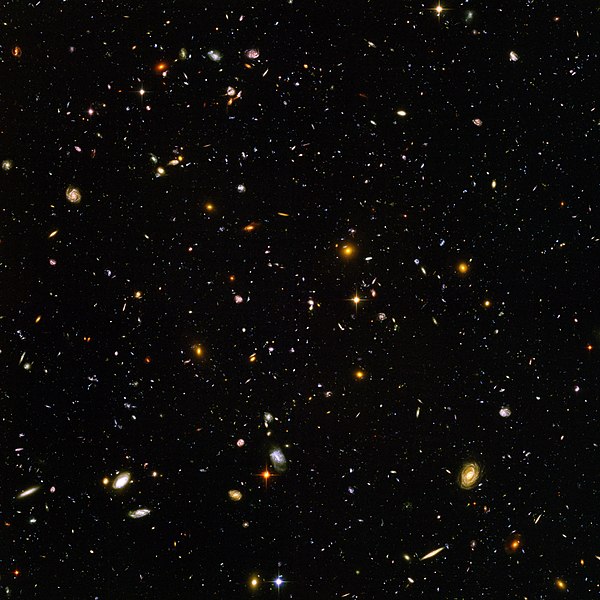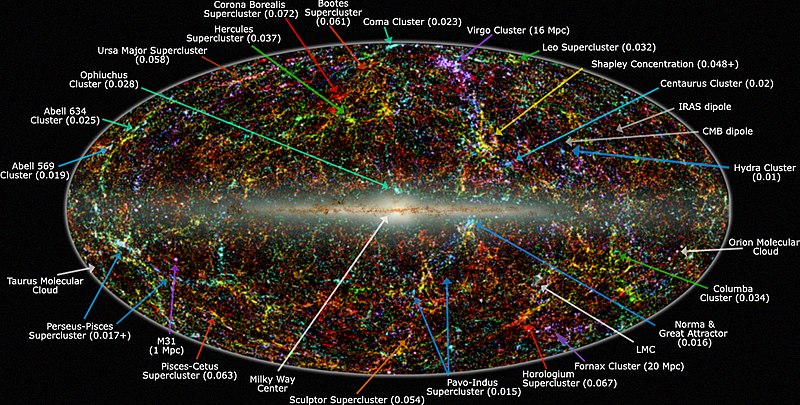By Alton Parrish.
Dark energy makes up about 70 percent of the current content of the Universe and thus holds the ultimate fate of our Universe. Several possible scenarios are possible depending on the properties of dark energy; one is that the Universe will end in a so-called big rip. This interesting topic was recently explored by five researchers from the University of Science and Technology of China, the Institute of Theoretical Physics at the Chinese Academy of Sciences, Northeastern University, and Peking University. Their work, entitled “Dark energy and fate of the Universe”, was published in Sci China-Phys Mech Astron 2012, Vol. 55 No. 7.
Estimated distribution of dark matter and dark energy in the universe
Credit: Wikipedia
For millennia, human beings have been pondering two ultimate questions: “Where do we come from?” and “Where are we going?” Over that time, these questions have spurred theological and philosophical debate. Thanks to the rapid development of modern cosmology in the past three decades, scientists nowadays have obtained some important clues to answer these questions. The standard “inflation + hot big bang” framework has been developed to explain the origin of the Universe. However, to forecast the destiny of the Universe, researchers have realized that the nature of dark energy is key.According to the Big Bang model, the Universe expanded from an extremely dense and hot state and continues to expand today. A common analogy explains that space itself is expanding, carrying galaxies with it, like spots on an inflating balloon. The graphic scheme above is an artist’s concept illustrating the expansion of a portion of a flat universe.
Credit:Wikipedia
In the absence of a consensus on what dark energy is, a phenomenological description of the equation-of-state parameter w—the ratio of pressure and density of dark energy—provides an important means for investigating dark energy dynamics. Properties of dark energy will decide the ultimate fate of the Universe. In particular, if w<-1 at some time in the future, dark energy density will grow to infinity in finite time, and its gravitational repulsion will tear apart all the objects in the Universe. This “big rip” (or “cosmic doomsday”) scenario is the major focus of the paper. “We want to infer from the current data what the worst fate would be for the Universe”, said the authors.
The Hubble Ultra Deep Field showcases galaxies from an ancient era when the Universe was younger, denser, and warmer according to the Big Bang theory.
Credit: Wikipedia
To foresee that fate, it is important to choose an appropriate parameterization that covers the overall expansion history of the Universe. The most popular Chevallier-Polarski-Linder (CPL) parameterization, in fact, is not suitable in predicting the future evolution of the Universe because in this form w will diverge when the redshift parameter approaches -1. Thus, the authors invoke a divergence-free parameterization, called the Ma-Zhang (MZ) parameterization, to predict the evolution of the Universe.One of the more intriguing questions is: “If a doomsday exists, how far are we from it?” After constraining the MZ parameter space via a Markov Chain Monte Carlo method, the authors found that by using the current observational data tBR – t0 = 103.5 Gyr for the best-fit result, and tBR – t0 = 16.7 Gyr at the 95.4% confidence level (CL) lower limit. Here tBR denotes the time of the big rip, and t0 denotes the present day. “In other words, at worst (95.4% CL), the time remaining before the Universe ends in a big rip is 16.7 billion years”, said the authors.
This panoramic view of the entire near-infrared sky reveals the distribution of galaxies beyond the Milky Way. The galaxies are color coded by redshift.
Credit: Wikipedia
Thus the constrained parameter space indicates that it is very likely that in the future w<-1. If so, one may ask another interesting question: “How about the destinies of the gravitationally bound objects in the Universe, such as galaxies and stars?” In fact, if w indeed ever becomes less than -1, dark energy’s gravitational repulsion will continuously increase until it overcomes all forces holding objects together and all objects will be torn apart. No object would escape this fate, but obviously systems more tightly bound would exist for longer.
Using the MZ parameterization, the authors speculated on a series of possible consequences before the cosmic doomsday. For example, for the worst situation, namely the 95.4% CL lower limit, the Milky Way will be torn apart 32.9 Myr before the big rip; two months before doomsday, the Earth will be ripped from the Sun; five days before the doomsday, the moon will be ripped from the Earth; the Sun will be destroyed 28 min before the end of time; and 16 min before the end, the Earth will explode.
This is an artist’s concept of the Universe expansion, where space (including hypothetical non-observable portions of the Universe) is represented at each time by the circular sections. Note on the left the dramatic expansion (not to scale) occurring in the inflationary epoch, and at the center the expansion acceleration. The scheme is decorated with
WMAP images on the left and with the representation of stars at the appropriate level of development.
Credit: NASA/WMAP Science Team
However, from what we already know of the dynamical properties of dark energy, one thing is all very clear, we still have a very long future ahead.








Nice post. I learn something new and challenging
on websites I stumbleupon everyday. It will always be helpful to read articles from other authors and practice a little something from their sites.
I think everyone like this blog!